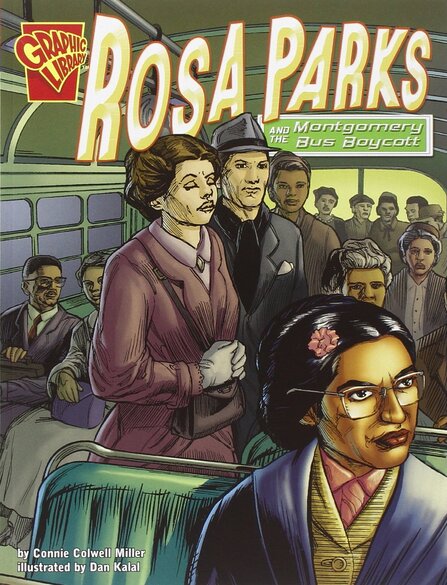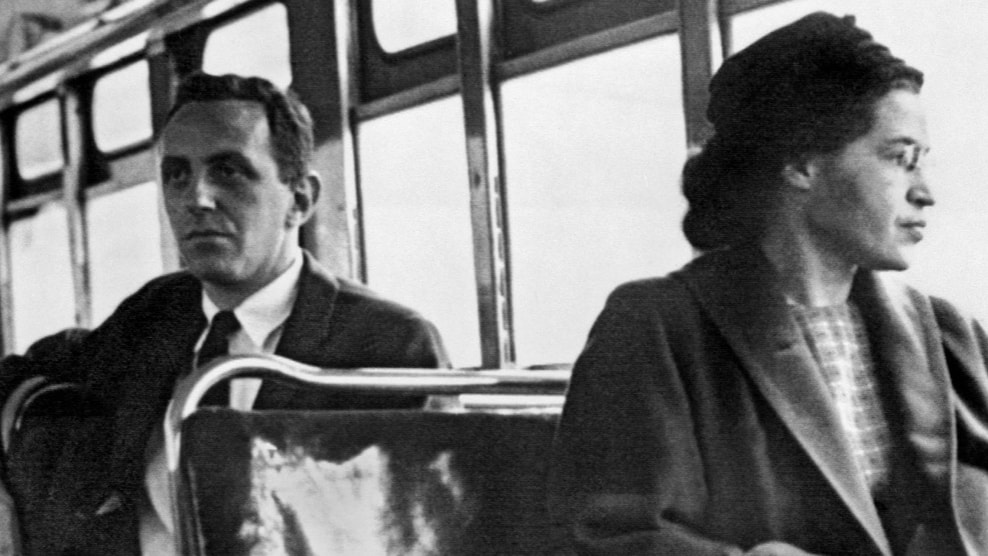Written by Juanita ‘Obi-Juan’ Bonner  Over the last decade or so, comics and graphic novels have truly started to come into their own. Once thought of as a niche market for… ahem… dare I say it… nerds (LOL!) alone, has now become ubiquitous. *ABOUT TIME… LOL!!* Massive box office hits based on comics as well as Comic Cons spread across the globe are also commonplace. So much so, that reading comics is now fashionable. *YES!* And, from where we sit here at Nerds That Geek, we couldn’t be happier!! *BIG GRIN* Adding to this – much to my delight – are educators who now use comics as a means to increase interest not only in reading, but historic events. A trend that I hope never ends!! So… as we head into Black History Month 2022, with education in mind, I’d like to take a look at a small graphic novel that shares one of the most historic events known round the world and the special lady who one day finally said no more in: Rosa Parks and the Montgomery Bus Boycott – RPMBB (Graphic Library via Capstone Press; 2007)! Starting with the author, let’s dive in! A teacher herself, Connie Colwell Miller has written multiple books for kids ranging from toddler to young adult as well as: “parenting essays and poetry online and in journals around the country.” *INSERT APPLAUSE HERE!* Additionally, along with Rosa Parks (1913-2005), Miller has also penned graphic novels about other notable women in history. Including the scientist and Nobel Prize Laureate Marie Curie (1867-1934) and the women’s rights activist Elizabeth Cady Stanton (1815-1902). *KAPOW* All three are reasonably priced and can be found virtually anywhere books are sold and shared – online or otherwise. Some of Miller’s works, including RPMBB, are even available to borrow online for free! *AWESOME!!* Set up more like a book than a comic, RPMBB has a Table of Contents that outlines the story in chapters 1-4. It also includes More About Rosa Parks and Read More sections along with a Glossary, Internet Sites, a Bibliography and an Index. All of which shows just how proper this graphic novel is and I LOVE IT!! There’s also an Editor’s Note pointing out – with page numbers and sources I might add (NICE!) – that all direct quotes within have a pale yellow background. I found this particularly awesome from a learning standpoint. Why? Because in the world of comics, any reader will tell you that different font or colors and various word bubble shapes and sizes are often used to make an individual stand out (i.e. the hero) or to highlight material. It’s fun and imaginative and I have always loved this when reading comics. Plus, using this method here emphasizes learning in general which is super cool!! And Kids, no doubt, will love it as well because these markers are smack dab in the middle of history and are placed directly within the cartoon images themselves. Comics… am I right?? I mean, honestly, long ago when so many erroneously said comics are for kids, THIS is literally what they SHOULD’VE meant… LOL!! And speaking of pictures… WOW!! Inked by Colorist Michael Kelleher, from beginning to end, the entire thing is filled with bright, bold colors. And as I walked through the chapters, I was inspired by not only the words but its images. Yet another thing that will catch a youthful eye! *BRAVO* My favorites include page 17 where a split screen shows both the local and Supreme Court victories against bus segregation; page 21 which shows a sea of people attending Dr. Martin Luther King’s great I Have a Dream speech at the Lincoln Memorial in 1963; and page 27 which show Mrs. Parks’ casket in 2005 – the first woman in US history to lie in state at the US Capitol Rotunda – as lines of people pass through to pay their respects. All of which mark major milestones not only in black history, but American history. *DAMN RIGHT!* Not to mention, the boycott itself, lasting 13 months, brought national attention to the struggle of African Americans everywhere and: “Launched Martin Luther King Jr. as the voice of the movement.” A fight, that sadly, continues to this day. *SIGH* But what about Rosa? Having lost her job due to the movement as well as receiving multiple death threats in its wake (*SIGH*), the Parks family decided to move to Detroit, Michigan. As the comic notes, Rosa continued her work with Dr. King, including attending the famous March on Washington preceding King’s renowned speech noted above and returning to Alabama two years later in 1965 to take part in the monumental Selma to Montgomery march to the state capitol. And even after Dr. King’s assassination in 1968 (*SIGH*), Rosa kept on. She knew then, just as so many of us know now, that the passage of the 1964 Civil Rights Act wasn’t enough. By 1987, along with Elaine Eason Steele (Twitter: @RosaParksPWF), the Rosa and Raymond Parks Institute was created ten years after her husband’s passing in 1977. Located in Detroit, the institute – a lifelong dream for Rosa: “Works to teach young people how to be good leaders,” and is still going strong today – 35 years later! *HECK YEAH!!* Admirably, Rosa, a member of the National Association for the Advancement of Colored People (NAACP) since 1943, worked on civil rights most of her adult life. The final page of the story ends with the aforementioned casket scene before moving on to the More about Rosasection. Each marked with a little yellow bus (LOVE THIS!!), seven sidenotes give more insight to Rosa’s story. Most notably for me?? That as a young girl, Rosa sat up at night with her grandfather to guard the house against KKK (Ku Klux Klan) attacks. WOW!! Talk about having to grow up too fast… sheesh! Additionally, I was completely unaware that two women prior to Rosa had refused to give up their seats on a bus: “But it was Rosa’s character that made her the best person to represent the fight for bus integration.” And finally, Rosa’s most prominent picture is discussed. Where, in 1956, she sat posed on a bus with a white reporter (Nicholas Chriss) behind her. Culminating in a true full circle moment, the same bus driver who threw her off the bus 12 years earlier and also had her arrested the year before sparking the heroic movement, was driving the day the photo was taken. Now, if that’s not an *IN YOUR FACE* moment, I don’t know what is… LOL!! The comic closes out with its Glossary defining six words: appeal, bail, boycott, integration, segregation and verdict. All of which often need explanation not only for children, but for some adults as well. This is followed by the Internet Sites section for facthound.com, which sadly is no longer in service. However, for those who are interested, the Read More and Bibliography Sections offer plenty of follow-up. *NICE!!*
Overall, this short graphic novel is chock-full of knowledge that any child would not only be able to comprehend, but discuss in depth. It’s a great way to show that one person truly can make a difference. And finally, it offers the chance to discuss the adversity African Americans have faced and continue to struggle with to this day. It’s far from the modern, and quite frankly, useless debates surrounding Critical Race Theory (CRT) strung throughout social and mainstream media as it plainly and simply states what was. Thus, allowing educators and students alike to draw lines in history that still affect ALL OF US today without pitting people against each other as the CRT debate has been so inappropriately hijacked to do. *EYE ROLL* For, history matters to us all and using comics to tell it is a fantastic source for bridging gaps young and old alike. As Rosa Louise Parks – The First Lady of Civil Rights – once said: “Differences of race, nationality or religion should not be used to deny any human being citizenship rights or privileges.” *HERE, HERE* Well, hopefully you enjoyed my mini history lesson. If so, please join me next time as we take a closer look at the events surrounding the Montgomery Bus Boycott and another Civil Rights icon via a different comic: Martin Luther King and The Montgomery Story (Fellowship of Recognition; 1957). Until then… remember: “There is no future without education” (R. L. Parks). ‘Rosa Parks and the Montgomery Bus Boycott’ - ISBN: 978-0-7368-6492-4 (Hardcover); 978-0-7368-9658-0 (Paperback) “Summary: In graphic novel format, tells the story of Rosa Parks arrest for not giving up her bus seat on December 1st, 1955, and the boycott it sparked.”
0 Comments
|
Archives
May 2024
|
|
© 2012-2025, Nerds That Geek LLC.
All Rights Reserved. |
uWeb Hosting by FatCow

